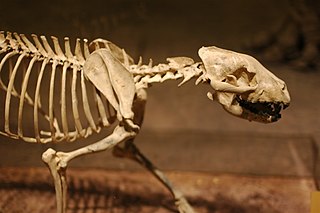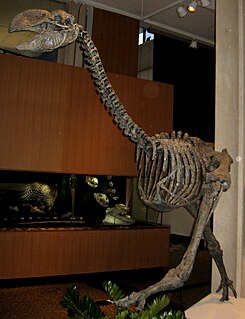 W
WAceratheriinae is an extinct subfamily of rhinoceros endemic to Asia, Africa, Europe, and North America during the Oligocene through Pliocene living from 33.9—3.4 mya, existing for approximately 30.5 million years .
 W
WAiluridae is a family in the mammal order Carnivora. The family consists of the red panda and its extinct relatives.
 W
WThe extinct Borophaginae form one of three subfamilies found within the canid family. The other two canid subfamilies are the extinct Hesperocyoninae and extant Caninae. Borophaginae, called "bone-crushing dogs", were endemic to North America during the Oligocene to Pliocene and lived roughly 36—2.5 million years ago, existing for about 33.5 million years .
 W
WDromornithidae, also commonly referred to as mihirungs, thunder birds or demon ducks, were a clade of large, flightless Australian birds of the Oligocene through Pleistocene Epochs. All are now extinct. They were long classified in Struthioniformes, but are now usually classified as galloanseres.
 W
WKentriodontidae is an extinct family of odontocete whales related to modern dolphins. The Kentriodontidae lived from the Oligocene to the Pliocene before going extinct.
 W
WObdurodon is a genus of extinct monotreme. They appeared much like their modern day relative the platypus, except adults retained their molar teeth. Unlike the platypus which forages on the lakebed, Obdurodon may have foraged in the water column or surface.
 W
WPampatheriidae is an extinct family of large plantigrade armored xenarthrans related to armadillos. However, pampatheriids have existed as a separate lineage since at least the middle Eocene Mustersan age, 45 to 48 million years ago. Pampatheres evolved in South America during its long period of Cenozoic isolation. Although widespread, they were less diverse and abundant than the armadillos. Holmesina spread to North America after the formation of the Isthmus of Panama as part of the Great American Interchange. They finally disappeared on both continents in the end-Pleistocene extinctions, about 12,000 years ago.
 W
WSagittariidae is a family of raptor with one living species—the secretarybird native to Africa.
 W
WScelidotheriidae is a family of extinct ground sloths within the order Pilosa, suborder Folivora and superfamily Mylodontoidea, related to the other extinct mylodontoid family, Mylodontidae, as well as to the living two-toed sloth family Choloepodidae. The only other extant family of the suborder Folivora is the distantly related Bradypodidae. Erected as the family Scelidotheriidae by Ameghino in 1889, the taxon was demoted to a subfamily by Gaudin in 1995. However, recent collagen sequence data indicates the group is less closely related to Mylodon and Lestodon than Choloepus is, and thus it has been elevated back to full family status by Presslee et al. (2019).
 W
WThe Temnocyoninae are an extinct subfamily of medium-sized bear dogs endemic to North America that lived during the Early Oligocene to Early Miocene about 30.8-20.43 million years ago (Mya) existing for around 10 million years.
 W
WTeratornithidae is an extinct family of very large birds of prey that lived in North and South America from the Late Oligocene to Late Pleistocene. They include some of the largest known flying birds.